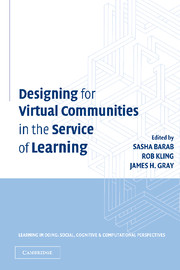Book contents
- Frontmatter
- Contents
- List of Contributors
- Series Foreword
- Foreword
- Preface and Acknowledgments
- In Memoriam
- PART I COMING TO TERMS WITH COMMUNITY
- PART II DESIGNING FOR WEB-SUPPORTED COMMUNITY
- 3 Designing System Dualities
- 4 Group Behavior and Learning in Electronic Forums
- 5 Teacher Professional Development, Technology, and Communities of Practice
- 6 Community of Practice
- PART III FOSTERING COMMUNITY/MEMBER PARTICIPATION
- PART IV RESEARCHING ONLINE COMMUNITY
- Index
- Titles in the series
- References
4 - Group Behavior and Learning in Electronic Forums
A Socio-Technical Approach
Published online by Cambridge University Press: 05 June 2012
- Frontmatter
- Contents
- List of Contributors
- Series Foreword
- Foreword
- Preface and Acknowledgments
- In Memoriam
- PART I COMING TO TERMS WITH COMMUNITY
- PART II DESIGNING FOR WEB-SUPPORTED COMMUNITY
- 3 Designing System Dualities
- 4 Group Behavior and Learning in Electronic Forums
- 5 Teacher Professional Development, Technology, and Communities of Practice
- 6 Community of Practice
- PART III FOSTERING COMMUNITY/MEMBER PARTICIPATION
- PART IV RESEARCHING ONLINE COMMUNITY
- Index
- Titles in the series
- References
Summary
The term community is widely and often uncritically used to characterize two kinds of groups that are central to this book. First, there are groups that come together to learn, in classes, workshops, and professional associations. Most professionals would refer to these as classes, workshops, and associations. Some educators like to refer to all of these kinds of groups as learning communities. The second kind of group is one that participates in an electronic forum (e-forum), such as an Internet Relay Chatroom, a professional listserv, a distance education course, or an online auction. It has become equally commonplace to refer to such groups as communities – virtual communities. This book examines issues for the developers and participants of electronic forums that could facilitate learning.
We believe that the casual use of the term community to characterize groups that are engaged in learning, or groups that participate in e-forums, is seriously misguided. As we shall see, developing a group into a community is a major accomplishment that requires special processes and practices, and the experience is often both frustrating and satisfying for many of the participants. The extent to which a group develops certain desirable community-like characteristics should be based on empirical observation rather than on assumptions or aspirations.
- Type
- Chapter
- Information
- Designing for Virtual Communities in the Service of Learning , pp. 91 - 119Publisher: Cambridge University PressPrint publication year: 2004
References
- 19
- Cited by



